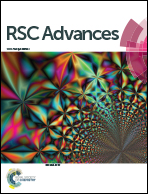The stability, characteristics and magnetic properties of iron carbide from an oolitic hematite†
Abstract
Iron carbide (Fe3C) is a magnetic material but it is not stable when it is prepared. Iron carbide was first prepared from high phosphorus oolitic hematite pellets using hydrogen reduction and was subsequently carburized with methane (CH4). The products were then cooled down to room temperature using three different cooling conditions: fast cooling, furnace cooling, and heat preservation for 2 h with subsequent fast cooling. The results showed that the optimal reaction conditions for the preparation of Fe3C from hydrogen reduced high phosphorus oolitic hematite are carburizing with CH4 for 15 min at 1023 K, then fast cooling with argon gas, thus a degree of carburization of 95.12% can be obtained. The heat preservation promotes the self-decomposition of Fe3C and the occurrence of multi-walled nano carbon fibers. The carbon nanotubes (CNTs) are in the form of rings, chains or nets, which can be attributed to the collisions between the CNTs. The nonuniform nano iron grains restrict the growth of CNTs deposited on the surface of metallic iron, and cause the bending of each CNT, which generates the chain or the net shape. Under fast cooling, the saturation magnetization declines from 82.59 to 61.97 emu g−1 as the time of carburization with CH4 increases from 10 to 30 min. The addition of the heat preservation and the control of the time of carburization with CH4 can give the desired saturation magnetization. The Fe3C prepared from high phosphorus oolitic hematite has relatively high magnetic properties.



 Please wait while we load your content...
Please wait while we load your content...